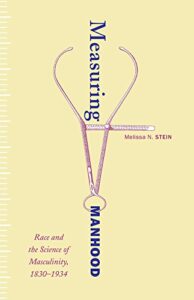Measuring Manhood: Race and the Science of Masculinity, 1830-1934 – Melissa N. Stein
 Measuring Manhood: Race and the Science of Masculinity, 1830-1934. By Melissa N. Stein. (Minneapolis: University of Minnesota Press, 2015. pp. 534. Cloth, $94.50. Paper, $27.00.)
Measuring Manhood: Race and the Science of Masculinity, 1830-1934. By Melissa N. Stein. (Minneapolis: University of Minnesota Press, 2015. pp. 534. Cloth, $94.50. Paper, $27.00.)
Reading this book was one of those times I wished I am more familiar with the historiography of race and sex/gender. Then I could tell how to situate this book in this historiography. For example, the fist chapters on race and gender during slavery read to me as very similar to other books I have read. However, because I am not familiar with the historiography, I can’t tell if Stein was an early contributor to this field, or if she is not necessarily making contributions that are new.
I found the narrative from the Civil War on to be similarly repetitive. For example, after emancipation and the passage of the thirteenth, fourteenth, and fifteenth amendments, the threat of black men as gendered actors became much more threatening to the white establishment because now they had citizenship and could vote. But Stein links this threat to manhood specifically because black women, like all women, did not win the right to vote and therefore were not a political threat to white dominance. Is this argument novel?
I suppose the most well-argued point on the centrality of black manhood and its relationship to white narratives of sex and gender came in the section on lynching. Black men became ciphers through which whites viewed Blacks’ supposed unsatiable appetite for white women. Any perceived slight or pursuit of white women by black men was a crime punishable by public torture and death. Some authorities proposed castration as an alternative to lynching, but in actuality, whites simple incorporated castration into lynching, making lynching a sexual spectacle of retribution against black men. While other writers have written about lynching and gender, the difference of opinion among whites on how to punish Black men was new to me.
Stein is upfront in representing her sources as the writing of elite white scientists. Through their writing she is able to trace static or change over time. She does focus on scholar and NAACP leader Walter White in the last chapter, including black voices in her narrative. I feel like the book may have been stronger if she had included more black voices as a counterpoint to whites, though Stein may reply that this focus would be outside the scope of her work. Therefore, Stein opens the door to other scholars to complete this research to compliment hers. This is one strength of the book.
On its own merits this is a interesting book with some limitations. For example, it wasn’t always clear when white scientists focused on men specifically or Blacks in general. For me, unlike for Stein, simply using male gendered pronouns in elite scientists’ work did not necessarily mean a focus only on men. Male pronouns are often gender default, so assuming males as the normative default gender can also subsume women under this label. Stein’s argument that white scientists’ use of male pronouns to mean only men was weakest in her chapters on slavery, but became more convincing as the Civil War and Reconstruction eras became specifically focused on Black men as citizens who needed to be policed to keep them from crossing the color line. As Stein points out, this meant regulating Blacks’ sexual access to white women, more often then not resulting in violence.
I suppose I should probably sit this one out, but I wanted to share my reactions. This book would be useful in a graduate course on gender and race, where students can parse the scope of Stein’s work and the role of manhood and race from slavery to the eve of the civil rights movement. It will be up to them and the more knowledgeable educators to determine Stein’s place in the historiography of the subject and the usefulness of her narrative within its own limited scope.
There also needs to be an analysis of the sources she used, and the note on sources at the end of the book and her extensive bibliography provide great places to start. One great thing about this book is that the research is always transparent. Like I said, it is begging for a sequel based on a Black counterpoint.
